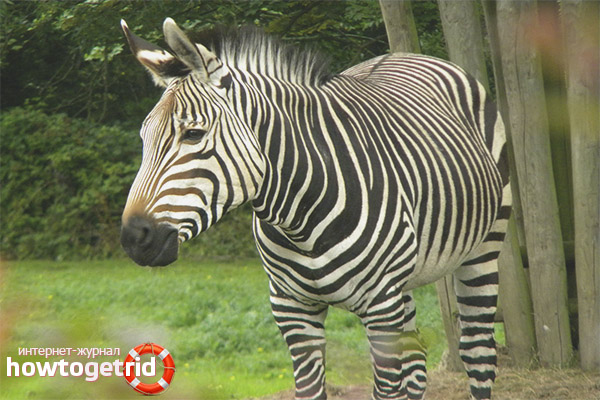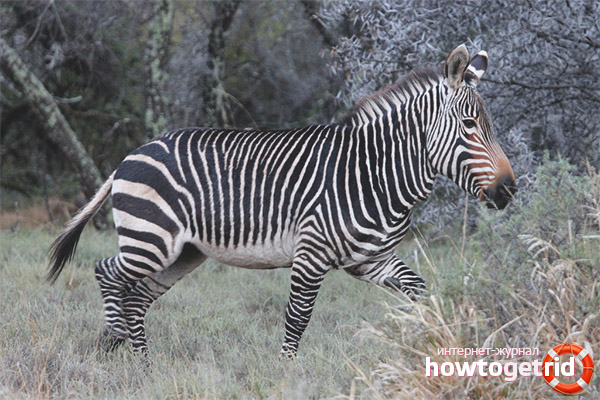The content of the article
Mountain Zebra is a species of zebra native to Southwest Angola, the mountainous regions of Namibia, and also Southwest Africa.
Habitat
Mountain zebras live in hot, dry, mountainous, rocky and hilly habitats. They prefer slopes up to 1,000 meters (3,300 ft) above sea level, although in winter they migrate lower. There are 2 subspecies of mountain zebras: Cape and Hartman.
Hartman's mountain zebra usually lives in coastal South Angola, as well as Namibia. They are clever climbers, able to live on arid steep mountains. These mammals demonstrate amazing climbing ability, capturing steep, rugged terrain with more confidence than zebra plains.
Mountain Zebra Description
This significant icon of Africa is a recognizable member of the horse family, characterized by a pattern of bright black and white stripes that pass into its short, straight mane. Mountain zebra differs from others in thin and relatively close vertical black lines on its neck and trunk, which, moreover, are more numerous than other species, as well as wide horizontal stripes on its hips, wider than others.
Unlike a flat zebra, the mountain zebra also lacks “shadow stripes”, and the stripes do not meet under the stomach. Instead, it is white with a central black stripe. However, the most diagnostic features of this species are the "mesh pattern" pattern of narrow strips along the croup and a square flap of skin, or undercoat, which exists on the throat of this zebra. Mountain Zebra is a good climber on a steep, rocky terrain. She developed very sharp and stiff hooves. Body length - up to 250 cm, tail length - 40-50 cm, shoulder height - 116-150 cm, weight - 240-372 kg.
Cape Zebra is the smallest living zebra. It differs from Hartman's zebra in its smaller size, slightly thicker black stripes and slight variations of the stripes on the sacrum.
Zebras have very good eyesight day and night. They have binocular vision in front and they can probably see in color. They also have excellent hearing that can detect sounds from a far distance. Mountain zebras also have a very keen sense of taste and can detect minor changes in the quality of their food.
Lifestyle
Zebras lead a daytime lifestyle, being active during the day and sleeping at night. They exhibit increased activity at dawn and dusk. Almost half of their active time is spent on feeding. In addition, they take dust baths 1-2 times a day.
This herd species lives in breeding herds, consisting of one adult male, from one to five adult females and their cubs. All members occupy a position in the social hierarchy, led by the dominant adult stallion, which is responsible for protecting the herd.
Breeding herds live in intersecting areas, without any signs of territoriality. And sometimes these herds even combine to form larger temporary populations of up to 30 individuals. Extra males live in groups from which people periodically try to create a new herd with young females, or take over the existing one, displacing the dominant stallion.
Breeding
This polygamous species reproduces throughout the year, although there are regional birth peaks. Females produce one foal every 1-3 years; the gestation period lasts approximately one year.While most mountain Cape zebras leave their maternal herds of their choice at the age of 13-37 months, or about three months after the birth of another cub, Hartman mountain zebras try to expel their 14-16 month old cubs from the herd before the birth of the next cub .
Young males can roam alone for a while before joining a group of bachelors, while females either climb into another breeding herd or join bachelors to form a new breeding herd.
Power Features

Their preferred food is green grass, but during periods of shortage, they begin to look for and eat bark, twigs, leaves, buds, fruits and roots. Individuals drink every day. When there is no surface water due to drought, they usually dig land in the dried river beds.
Main threats
The main threats to the mountain zebra are competition with livestock, hunting and harassment, loss of habitat due to agriculture, and the risk that the two subspecies will interbreed with each other, resulting in a loss of genetic diversity.
Cape Zebra used to occupy all the mountain ranges of the Southern Cape Province of South Africa, but by 1997 there were fewer than 750. This subspecies is the largest mammal in South Africa, which is close to extinction. Despite the fact that they probably never had too many, their numbers declined as herds had to compete with sheep and cattle for pasture, as their habitat was increasingly turning into agricultural land. Hunting was also uncontrollable, and this zebra was a frequent victim.
Although both subspecies of mountain zebras are currently protected in national parks, they are still under threat. A European program has been created for them to study endangered animal species and to jointly manage zoo populations around the world.











Submit